David Meyer's Blog, page 9
May 25, 2013
Learning how to Draw: When is it too Late?
I am the worst artist in the world. But not for much longer. I’m going to teach myself how to draw. That is, if it’s not too late…

A David Meyer Original! Wow, these are not good. Well, this is a house, an airplane, and a not-so-tasty bagel. Whatever you do, don’t eat it!
It’s Day 6 of my “open novel” experiment for Ice Storm, aka my “Development Hell” book. Yesterday, I reached 21,000 words of the second draft. Just 69,000 words to go. As expected, it was a tough day. I had to write a new chapter and shift parts of two other chapters around. I cannot begin to describe how much I despise writing new material while editing old material at the same time. It’s exhausting. But at least I’m still on target to finish this draft by June 30.
Learning how to Draw: When is it too Late?
I’ve always wanted to learn how to draw. Unfortunately, I never got past the stick-figure stage. But I’m determined to change that. My brain likes to work in a frenetic fashion. Sometimes I’m writing one story while my brain is focused on two other ones. It can be difficult to keep track of everything. So, I’ve started to storyboard future novels. I take these large pieces of poster board and scribble ideas and little drawings onto them. Unfortunately, my drawings are just awful. And that’s no good because I have a lot of visuals I’d like to put down on paper.
So, I bought myself a couple of how to books from Amazon. I picked You Can Draw in 30 Days by Mark Kistler and Drawing for the Absolute Beginner by Mark and Mary Willenbrink. I’m going to be working out of them for the next few weeks so expect to see plenty of photos of my work. As a starter, I took the advice of Mark Kistler and sketched a house, an airplane, and a bagel (yes, that’s what those drawings are supposed to be!).
Hopefully, I’ll learn a few things. Further down the road, I’d love to draw as another form of entertainment. I’m a huge fan of old school comic strips (Dick Tracy, Terry and the Pirates, Steve Canyon, X-9, Li’l Abner, and Rip Kirby volumes all line my bookshelves). It would be an interesting challenge to create my own adventure comic strip. I’m also interested in creating a Cy Reed-based adventure video game using Adventure Game Studio.
Other Stuff
The link to buy Chaos at Diesel (see sidebar) is still broken. On the bright side, things are moving forward and from what I understand, Diesel received a revised version of Chaos yesterday that should fix the problem. Also, I just realized my Goodreads link isn’t working. This seems to be a coding problem as the widget I use for social networking doesn’t have an “author” function. Finally, the Chaos paperback is still on sale for $13.25 at Amazon. Get it while it’s cheap!
The post Learning how to Draw: When is it too Late? appeared first on Guerrilla Explorer.
Related posts:
Ice Storm: Not just another Cop Novel!
Writer’s Guilt – My Greatest Nemesis!
Development Hell to Development Heaven!

May 24, 2013
Writer’s Guilt – My Greatest Nemesis!
I am plagued by a constant case of writer’s guilt. Never heard of writer’s guilt? Well, read on…

View from Flores, El Petén. Peaceful right? Well, less than 24 hours later our van crashed into a police car…next to a military outpost. Next thing I knew, soldiers were swarming us and I was being directed into an ambulance. Ahh, Flores…
This is Day 5 of my humble little “open novel” experiment for Ice Storm, aka my “Development Hell” book. Yesterday, I edited the 18,000th word of the second draft. Just 72,000 words to go. Good lord, that seems like a lot. Especially since yesterday was a pretty tough day. I’m officially through the easy stuff. From here on out, it’s going to be a battle. I hope to edit another 3,000 words tomorrow. Then I’ll be taking a few days off.
Writer’s Guilt – My Greatest Nemesis!
And that brings me back to my first point. I’ve been writing fiction for a number of years now. But for a variety of reasons, I don’t have much to show for it. I’ve written countless scenes. And I’ve learned a lot about writing and myself. Still, I’ve only published one book (shameless plug: it’s called Chaos!). Because of this, I have trouble taking time away from writing. When I do, I get writer’s guilt. It’s this gnawing feeling in the pit of my stomach that I haven’t actually earned a break. It’s brutal, similar to the guilt I used to feel when I didn’t do my homework on time. Actually, scratch that. I never did my homework on time. Heck, I didn’t pay attention in a single class until I got to Business School (Umm…hi mom and dad…). But that’s another story for another time.
The worst thing about writer’s guilt is that it’s ultimately self-defeating. Doing things, going places, living life…these things enhance fiction not detract from it. Plus, breaks can be enormously helpful when it comes to recharging mental batteries. But my brain doesn’t really care about such things. So, I get writer’s guilt before vacations. I get it before holidays. I get it before day trips. I even get it when I’m not actually missing any of my writing time. Weird huh? Oh yeah, I often get it well in advance of the actual break. And the guilt continues well after I’ve already taken the break. Strangely enough, I usually do fine during the break itself (note to self: take longer breaks).
So, with a break coming up, you might think I’m feeling a severe case of writer’s guilt. But so far it hasn’t happened. Famous last words right? But truthfully, that’s a big deal for me. I’d like to think it’s because I’ve got a plan in place to finish Ice Storm. But maybe my brain is just tired of harassing itself. Regardless, I’m pleased.
Other Stuff
I feel like a broken record here. But the link to buy Chaos at Diesel (see sidebar) is still broken. And the Chaos paperback is still on-sale for $13.25 at Amazon. Get it while it’s cheap!
The post Writer’s Guilt – My Greatest Nemesis! appeared first on Guerrilla Explorer.
Related posts:
Get me out of this Development Hell!
President Lincoln’s Greatest Nemesis?
Ice Storm: Not just another Cop Novel!

May 23, 2013
Development Hell to Development Heaven!
Wow, it was quite the storm here the other night. Torrential rain. Loud, ripping thunder. Blinding flashes of sheet lightning. Truly awe-inspiring stuff. As a result, I’m feeling a bit more contemplative than usual today. By the way, I didn’t have my camera handy during the storm. The accompanying picture is actually from another storm (way back in 2011).
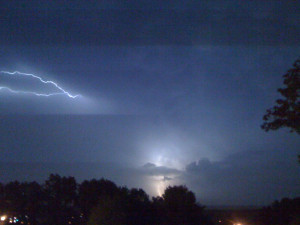
Capturing a little lightning…
This is Day 4 of my humble little “open novel” experiment. Let’s start with a quick update on my “Development Hell” novel, Ice Storm. Yesterday, I edited my 15,000th word of the second draft. I’m guessing I’ve got 75,000 words to go. The next 15,000 words should be a little tougher. Then things get really tough. Then a little easier. Then tough again.
From Development Hell to Development Heaven!
I’ve talked about Ice Storm’s development hell over the last few days. But to sum up, I wrote seven unfinished drafts over the course of four to five months. Finally, I got tired of spinning my wheels and combined the drafts, forming a story out of the various pieces. The result was less than good. However, the story had lots of potential. Last week, I spent three nights trying to pinpoint what was holding it back. I came up with two major problems and two minor ones.
Scenic Confusion: The scenes felt strangely out of order. Sort of like I’d tossed them into a blender and let them splatter out over the pages.
Passive Hero: Cy Reed was not driving the action. Instead, things sort of happened to him and he reacted accordingly. When he makes a fantastic discovery near the end of the novel, it felt unearned.
Side Story Issues: Chaos was light on secondary characters. Ice Storm is far more ambitious. Several of the secondary characters have their own stories that unfold over the course of the novel. For the most part, I liked these side stories but felt I didn’t wrap them up well.
Cartoonish Events: Cy Reed’s universe is supposed to be a little over-the-top. His world is filled with lost treasures, deadly monsters, and strange science. But it’s all grounded in reality. The mysterious artifact at the heart of Chaos, die Glocke, is fully explainable by modern science. Ice Storm was different. I strayed from reality and got a little too cartoonish at times. Hell, it strained even my credulity.
In retrospect, none of this surprises me. As I mentioned, I crafted Ice Storm out of multiple drafts. It was only natural that scenes get out of order, motivations get obscured, etc. Fortunately, these problems are manageable. Here’s what I did. I took a sheet of paper and divided it into six boxes. Then I divided Ice Storm into six sections, one for each box. In each section, I gave Cy an overall goal. By the end of the section, he either accomplishes the goal or fails and is forced to improvise. This leads to the next section and the next goal. It worked like magic for me. Cy is now driving the story rather than being driven by it.
Then I divided up my individual scenes and put them into the various sections. I had to throw a few away (hmm…maybe I’ll do a “Deleted Scenes” section after Ice Storm is published). And I’m going to have to create a few to replace them. But most of my scenes found a much better home. Now, it feels like there is a more logical progression of the story.
The division of sections also helped out with the side stories. I took each secondary character and figured out what part of their story would be told in each section. It also helped with the cartoonish elements. I was able to eliminate two particularly cartoonish elements merely by reordering the scenes. I also took the opportunity to reground the story based on the principles of Cy Reed’s world.
So, there you have it. Development Hell to (possible) Development Heaven all in a matter of three days!
Other Stuff
The link to buy Chaos at Diesel (see sidebar) is still broken. And the Chaos paperback is still on-sale for $13.25 at Amazon. Incidentally, that price may go up soon. I’m thinking about participating in Amazon’s Extended Distribution program. But the only way to make a decent profit off it is to raise the Amazon paperback to a higher price, say $17.95. I’ve been mulling this over for awhile. Still, if you’re thinking about buying a copy, now might not be a bad time to do it.
The post Development Hell to Development Heaven! appeared first on Guerrilla Explorer.
Related posts:
Get me out of this Development Hell!
Ice Storm: Not just another Cop Novel!
First Review for Chaos…

May 22, 2013
Ice Storm: Not just another Cop Novel!
Let’s talk about my work-in-progress. It’s tentatively titled Ice Storm. The “first draft” (read yesterday’s post to see what I mean by this) came in at 85,000 words, or 340 pages. I’m in the process of editing it and reached the 12,000 word mark today. So, I’m still on schedule. Sweet. Then again, this part of the book happens to be in pretty good shape. It’s the next 73,000 words that are going to give me fits. So, not so sweet after all.
Ice Storm: Not just another Cop Novel!
[image error]
Come on snow…is that all you’ve got???
Ice Storm is the second novel in the Cy Reed universe. Cy Reed is an urban archaeologist turned treasure hunter. I used to feel a little silly writing about a treasure hunter. I mean, come on…treasure hunting is hardly a real profession. How many full-time treasure hunters are out there anyway? But that’s sort of the point. Fiction (and not just literature) is dominated by the usual suspects: cops, lawyers, doctors, bureaucrats, etc. They’re a dime a dozen. Does the world really need another novel about a world-weary, rule-bending, alcoholism-recovering, family-failing, overworked cop? Actually, maybe so. For some reason, readers gobble those up like crazy.
But as for me, I don’t have much interest in conventional characters. I prefer characters who operate on the fringes of society and respectability. I think it opens up a lot of interesting story lines and points of view you don’t see in most novels. Take Cy Reed for example. He’s got one foot in the world of archaeology and the other foot in the world of treasure hunting. His former colleagues view him with disdain. His new ones view him with distrust. He doesn’t really fit into either world and probably never will. At the same time, his position on society’s totem pole affords him an unusual outlook. He sees the hidden flaws in the archaeological industry. He thinks antiquities laws are wrongheaded and do more damage than good. And he views smugglers, looters, and black market dealers in a rather positive light. In short, he defends the “undefendable.”
My first book in the Cy Reed Universe, Chaos, takes place in Manhattan. It’s a good old fashioned treasure hunt set in the middle of the urban jungle. Rather than mountains, Cy climbs a skyscraper. Rather than venturing into forgotten caves, he explores abandoned subway tunnels. When it came time to write a sequel, I considered writing another urban-based adventure, perhaps in a different city. But it had a “been there, done that” feel to it. So, I decided to take Cy in a completely different direction.
Ice Storm takes place in Antarctica, which in many respects is the exact opposite of Manhattan. There are no paved streets, few buildings, and very little in the way of permanent population. Manhattan is a bustling metropolis. Antarctica is mostly lifeless tundra. And yet, Ice Storm is very much about life. I’ll return to this point over the coming weeks, but suffice it to say a lifetime isn’t enough for Cy Reed to accomplish all of his dreams. As you might’ve guessed, I have that in common with him.
Other Stuff
By the way, the link to buy Chaos at Diesel (see sidebar) is broken. Don’t know how that happened but I’ve been told it’s in the process of being fixed. Oh and Amazon lowered the price of the Chaos paperback to $13.25. Apparently, I still get the same commission. So, you can save a whopping $0.70 and I still get full payout. Good deal!
The post Ice Storm: Not just another Cop Novel! appeared first on Guerrilla Explorer.
Related posts:
5-Star Review for Chaos!
Chaos is Coming!
One More Day Until…CHAOS!

May 21, 2013
Get me out of this Development Hell!
Check out that chart over there. What? You can’t read it? Okay, click on it. That should help.

My Writing Schedule – April 2013 – September 2015 (Yes, you read that right!)
This is my writing schedule. I created it last month. You see, I have a tendency to write books straight into development hell. I’ll write 50,000 words (200 pages) of a novel. Then I’ll conclude I made some crucial error. I’ll start to rewrite. I’ll add new chapters and eliminate old ones. Ill get maybe 30,000 words into a second draft before I realize I made another set of crucial errors. So, I’ll rewrite again. And again. And then again.
The result is an incoherent mess, filled with various parts from various drafts. Eventually, I give up and move onto another story. And then I go through the same process all over again. I think it happens because: a) I’m a perfectionist and fiction, by definition, will always be imperfect; and b) I tend to rush into stories before I’ve really had proper time to brainstorm them.
I’m determined to break the cycle. So, I created a schedule for my next four books and set some rules for myself. I’ve also started to storyboard future novels (that’s the reason I’ve got four books on the schedule). The basic idea is to extend the creation period as well as separate creation from editing. If I do it right, I think I can write a novel every eight months. That’s two months apiece for brainstorming, writing, editing, and publishing.
Brainstorming: Far too often I rush into a story only to find I don’t like where it’s going. The characters seem thin, the story feels off. So, I want to lengthen my pre-writing creation process.
Writing: I write 2,000 words per weekday and 1,000 words per weekend day. So, 12,000 words per week. That means I can write about 100,000 words (400 pages) over a two month period (I consider 75-90,000 words to be my sweet spot).
Editing: I’m going to need two months to edit my current novel. But going forward, I’d like to reduce that time and instead, place more trust in my creative work.
Publishing: This is all the other things that go into publishing a book…soliciting suggestions from outside readers, formatting the book, and creating a cover.
So, where do we stand? I started my current book, tentatively titled Ice Storm, back in December 2012. After spinning it off into development hell, I resurrected it. Basically, I took pieces from seven (!) different drafts and shoved them together. I finished this on May 16. For the sake of simplicity, I’m considering this to be my first draft.
It’s not very good. In fact, it’s exactly what you’d expect from shoving seven different drafts together. But it has tons of potential. Over the last few weeks, I’ve developed a plan to realize this potential. It’s going to take some work. Generally speaking, the first 15,000 words are almost perfect. Another 15,000 words will have to be replaced completely. The remaining 55,000 words will require reshuffling and minor to major editing.
I started editing on May 18 at a rate of 18,000 words per week. It’s slower than I’d prefer. But like I said, Ice Storm needs a lot of work. I got to 9,000 words yesterday. If all goes well, I should be able to finish this draft by the end of June. I’ll spend July tightening it up. I’d like to give it to my first reader (Hi Julie!) by August. I plan to publish it by the end of September.
Either Ice Storm will turn into a spectacular book or it’ll become a train wreck of epic proportions. Regardless, you’ve got a front-row seat to watch it all go down. So, stick around. It’s going to be one hell of a ride!
The post Get me out of this Development Hell! appeared first on Guerrilla Explorer.
Related posts:
The Future of Guerrilla Explorer?
Happy Guerrilla Explorer Day!

May 20, 2013
The Future of Guerrilla Explorer?
Change is a good thing…I think.

Here I am!
Back in 2011, I was hard at work on a novel, which I eventually published as Chaos. I’d already decided to self-publish it. But I had no clue how to sell it. So, I followed the path taken by many other authors. I started a blog on May 21, 2011 called “The Life of a Thriller Author.” I updated it regularly, writing about the business of writing. I created a Twitter account and reached out to authors. I started following blogs written by those same authors. In short, I immersed myself completely within the community of on-line authors.
And that was a problem. I came to believe that authors, by and large, were too insular. They were so busy talking to each other that they didn’t have much time left over for their readers. So, on June 28, 2011, I shut down “The Life of a Thriller Author.” The next day, I launched Guerrilla Explorer. For almost two years, I’ve written articles on mysteries of history, lost treasure, and strange monsters. It’s been an amazing experience and I’ve enjoyed every second of it. However, I’ve begun to question it as well. Guerrilla Explorer requires a lot of time and research. It often distracts me from my real goal, which is to write fiction. Plus, I’m not sure it’s doing a good job connecting readers to my fiction.
So, I want to try an experiment. I want to write about writing again. But this time, I don’t want to write about the business end of it. I want to write about creation. I love talking about creativity. It’s one of my greatest passions.
For the next few days, I’m going to give you a front-row seat to the development of my upcoming book as well as future projects (I work on three or four books at a time). I want to talk about my inspirations. I want to show you my character sketches. I want to unveil my storyboards. And since fiction is always influenced by life, I want to open up that door to you as well. That’s no simple task. As my closest friends can attest too, I’m notoriously close-lipped.
I don’t want to give away major plot points. But I would like to give you an inside look at how I create stories. If it goes well, I’ll expand the experiment. If not, I’ll switch back to the usual stuff you’ve come to expect from me. But ultimately, I’d love to use this site to give you greater access to the worlds I create. In the future, that could involve short stories, contests, comics strips, video games, etc.
So, stick with me and let’s see where this goes. Change is a good thing…
I think.
The post The Future of Guerrilla Explorer? appeared first on Guerrilla Explorer.
Related posts:
Happy Guerrilla Explorer Day!
What’s Next for Cy Reed?
5-Star Review for Chaos!

April 11, 2013
Underwater Pyramid: What is the Galilee Anomaly?
Recently, a team of researchers discovered a giant underwater pyramid beneath the Sea of Galilee. What is the Galilee Anomaly?
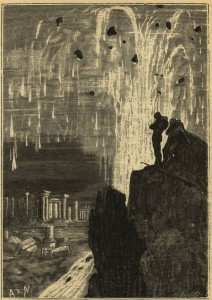
Underwater Pyramid: What is the Galilee Anomaly?
Description: Professor Aronnax and Captain Nemo visit the ruins of the lost world of Atlantis
Illustration by Alphonse de Neuville and Edouard Riou
Source: Wikimedia Commons
What is the Galilee Anomaly?
Well, it looks like we’ve got another Baltic Anomaly on our hands. Here are the details. During the summer of 2003, a sonar survey captured an image of a large cone-shaped structure in the southwest part of the Sea of Galilee. Almost ten years later, divers finally investigated the strange underwater pyramid.
They found “a conical stone pile built of large, natural, unhewn basalt cobbles and boulders” at a depth of 220 meters. The underwater pyramid rises 10 meters off the seafloor with a diameter of 70 meters. Incidentally, the individual boulders show no signs of human activity.
“Close inspection by scuba diving revealed that the structure is made of basalt boulders up to 1 m long with no apparent construction pattern. The boulders have natural faces with no signs of cutting or chiselling. Similarly, we did not find any sign of arrangement or walls that delineate this structure.” ~ Yitzhak Paz, Moshe Reshef, Zvi Ben-Avraham, Shmuel Marco, Gideon Tibor, and Dani Nadel, A Submerged Monumental Structure in the Sea of Galilee, Israel
Underwater Pyramid: Manmade or Artificial?
Although the boulders show no signs of being worked, the team is convinced this underwater pyramid is a manmade structure. The reason? It appears unnatural and other basalt boulders were not found in the area.
“The shape and composition of the submerged structure does not resemble any natural feature. We therefore conclude that it is man-made and might be termed a cairn. The boulders had to be transported at least a few hundred metres from the nearest basalt outcrop.” ~ Yitzhak Paz, Moshe Reshef, Zvi Ben-Avraham, Shmuel Marco, Gideon Tibor, and Dani Nadel, A Submerged Monumental Structure in the Sea of Galilee, Israel
They think the structure was built on dry land, possibly more than 4,000 years ago. This would match up with other megalithic architecture in the area. But while those ones were spared, the Galilee Anomaly was eventually washed over by the Sea of Galilee. Incidentally, the structure is located a mile north of the ancient city of Khirbet Kerak.
Guerrilla Explorer’s Analysis
The Galilee Anomaly, as I like it call it, is an exciting discovery. But I’m not fully convinced this underwater pyramid is manmade. Just because it appears unnatural doesn’t mean it is unnatural. I’ve touched on this in a previous article, namely how people tend to think certain angles, shapes, and rock formations can’t exist in nature.
“After all, right angles don’t exist in nature right? Wrong. The right angle, contrary to popular opinion, does exist in nature. It’s not some secret invention of mankind. It is just as likely to appear in nature as any other angle. However, nature shows no bias toward the right angle while mankind, on the other hand, makes extensive use of it. Thus, when we see right angles in nature, we’re inclined to immediately suspect artificial origin.” ~ David Meyer, The Baltic Anomaly: Is it Natural…or Artificial?
Also, the team has yet to conduct a full search of the underwater pyramid. There may yet be signs of a basalt outcropping in the area. Until the team conducts a full archaeological excavation, it will be impossible to know for sure.
The post Underwater Pyramid: What is the Galilee Anomaly? appeared first on Guerrilla Explorer.
Related posts:
The Baltic Anomaly: Is it Natural…or Artificial?
How was the Great Pyramid built?
Secret Shafts within the Great Pyramid

April 10, 2013
Beale Codes: Solving an Unsolvable Code?
Between 1819 and 1821, Thomas Beale buried a giant treasure in Virginia. It has never been found. The key to its location lies in one of the most mysterious codes in history…the Beale Codes. But how does one go about solving an unsolvable cipher?
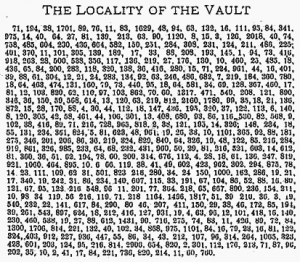
Beale Code #1
Source: Archive.org
The Mysterious Beale Treasure?
Last Friday, I posted the first story in a short series about the mysterious Beale Treasure. On Monday, I posted the second installment. Yesterday, I discussed whether the Beale Codes are real or a giant hoax. To recap, Thomas Beale and thirty other people excavated a massive treasure between 1819 and 1821. They reburied it in Virginia’s Blue Ridge Mountains. Then Beale created three ciphers now known as the Beale Codes.
“The Beale Ciphers were three codes which would enable one to locate the treasure and distribute it to the rightful heirs in the event that the group didn’t survive. The first Beale Cipher revealed the location of the vault. The second Beale Cipher described the contents of the vault. And the third Beale Cipher provided names and residences of the group members as well as their heirs.” ~ David Meyer, Beale Ciphers: A Lost Treasure?
Only one of the Beale Codes – the second one – has ever been decoded. It revealed the exact contents of the treasure.
“I have deposited in the county of Bedford, about four miles from Buford’s, in an excavation or vault, six feet below the surface of the ground, the following articles, belonging jointly to the parties whose names are given in number three, herewith: The first deposit consisted of ten hundred and fourteen pounds of gold, and thirty-eight hundred and twelve pounds of silver, deposited Nov. eighteen nineteen. The second was made Dec. eighteen twenty-one, and consisted of nineteen hundred and seven pounds of gold, and twelve hundred and eighty-eight of silver; also jewels, obtained in St. Louis in exchange for silver to save transportation, and valued at thirteen thousand dollars. The above is securely packed in iron pots, with iron covers. The vault is roughly lined with stone, and the vessels rest on solid stone, and are covered with others. Paper number one describes the exact locality of the vault, so that no difficulty will be had in finding it.” ~ Thomas Jefferson Beale, Decoded Version of Beale Cipher #2
Solving Beale Code #2?
Beale Code #2 is a book code. The “book” is the U.S. Declaration of Independence. In order to solve it, you take each number from the code and compare it to the relevant word in the document. Then you take the first letter from that word. So, the first number is 115. The 115th word in the Declaration of Independence is “instituted.” And the first letter in “instituted” is i. Below, you can see Beale Code #2 for yourself, as presented in The Beale Papers, Containing Authentic Statements Regarding the Treasure Buried in 1819 and 1821, Near Bufords, in Bedford County, Virginia, and which has Never Been Recovered:
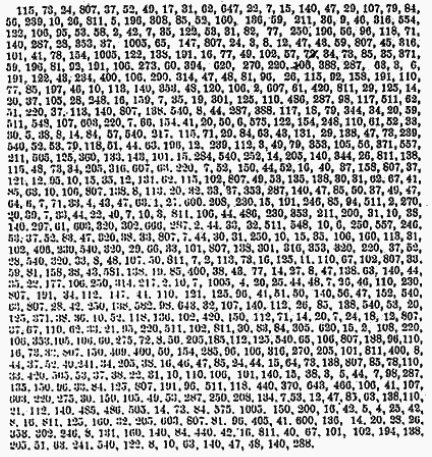
Beale Code #2
Source: Archive.org
This code was supposedly solved by a “friend” of Robert Morriss. The friend claimed to have stumbled upon the solution. I’ve always considered this one of the hardest parts of the Beale story to swallow. Without the key, a book cipher would’ve been pretty much impossible to solve at the time. Oh yeah, and the Declaration used to encode Beale Cipher #2 contains numerous mistakes. And yet, the friend was still able to figure out those mistakes. So, either the entire thing is a scam or the friend was using a similar version of the Declaration (actually, that second option isn’t impossible to believe…flaws abound in early reprintings of the Declaration).
Solving the Unsolvable Ciphers?
Assuming the Beale Codes are real, it stands to reason the remaining ciphers are encoded like Beale Code #2. That means there are two ways to solve them. First, a budding treasure hunter could search for the right key. This would involve seeking out texts of the time period and comparing them to the ciphers. One interesting idea presented by Tim Haydock in his book, Treasure Trove, plays off the fact that Beale’s full name was Thomas Jefferson Beale. Beale Code #2 was encoded with the Declaration of Independence, which is usually associated with Jefferson. So, Beale Code #1 might correspond to someone named Thomas (perhaps Thomas Paine). Beale Code #3 would then be deciphered with something having to do with the name Beale. An alternative suggestion is that all three documents might link to works published by Thomas Jefferson.
The second approach is to employ computers in a brute force attack. I believe this has been done in the past, but I’d be curious to know what modern computers could do with it.
Regardless, here are the remaining Beale Ciphers for those of you who wish to try your hand with them.
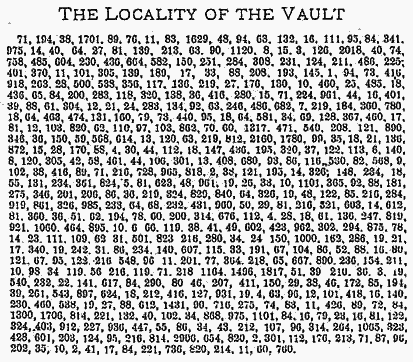
Beale Code #1
Source: Archive.org

Beale Code #3
Source: Archive.org
Guerrilla Explorer’s Analysis
Before you run off searching for old books, there are two things you should know. First, some scholars think the Beale Codes story is nothing more than a Masonic allegory.
Actually, of course, Beale and his treasure are illusory-merely part of an allegory meant to evoke the anticipated Masonic “discovery of the secret vault and the inestimable treasures, with the long-lost word” (as expressed in the Royal Arch degree). The contrast between the futile quest for gold and that for more spiritual wealth are didactically expressed in the allegory.” ~ Joe Nickell, Mysterious Realms: Probing Paranormal, Historical, and Forensic Enigmas
And second, in 1980 Jim Gillogly used the same Declaration of Independence in an attempt to decipher Beale Code #1. This resulted in some curious strings of letters such as AAA, TTTTT, and most interesting, ABFDEFGHIIJKLMMNOHPP. Gillogly concluded that Beale Code #1 was fake, created by randomly selecting words out of the Declaration that, at least in part, formed the alphabet. On the other hand, this could indicate a two-stage code. In other words, the alphabetic sequence might line up with a keystring. Regardless, it seems almost certain at this point that the Declaration of Independence was used in some manner to create Beale Code #1.
The post Beale Codes: Solving an Unsolvable Code? appeared first on Guerrilla Explorer.
Related posts:
Beale Ciphers: A Lost Treasure?
Beale Ciphers #2: A Massive Treasure Revealed?
Beale Treasure: Real…or a Giant Hoax?

April 9, 2013
Beale Treasure: Real…or a Giant Hoax?
Between 1819 and 1821, Thomas Beale buried a giant treasure in Virginia. The Beale Treasure has never been found. The key to its location lies in one of the most mysterious codes in history…the Beale Ciphers. But is the Beale Treasure even real? Or is it a giant hoax?
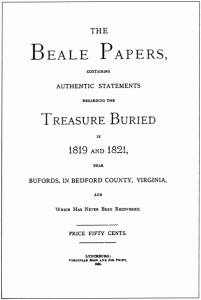
Is the Beale Treasure real…or a giant hoax?
Description: Cover of the Beale Papers (published 1885)
Source: Wikimedia Commons
The Mysterious Beale Treasure?
Last Friday, I posted the first story in a short series about the mysterious Beale Treasure. Yesterday, I posted the second installment. To recap, Thomas Beale and thirty other people excavated a massive treasure between 1819 and 1821. They reburied it in Virginia’s Blue Ridge Mountains. Then Beale created three ciphers now known as the Beale Ciphers.
“The Beale Ciphers were three codes which would enable one to locate the treasure and distribute it to the rightful heirs in the event that the group didn’t survive. The first Beale Cipher revealed the location of the vault. The second Beale Cipher described the contents of the vault. And the third Beale Cipher provided names and residences of the group members as well as their heirs.” ~ David Meyer, Beale Ciphers: A Lost Treasure?
Only one of the ciphers – the second one – has ever been decoded. It revealed the exact contents of the treasure.
“I have deposited in the county of Bedford, about four miles from Buford’s, in an excavation or vault, six feet below the surface of the ground, the following articles, belonging jointly to the parties whose names are given in number three, herewith: The first deposit consisted of ten hundred and fourteen pounds of gold, and thirty-eight hundred and twelve pounds of silver, deposited Nov. eighteen nineteen. The second was made Dec. eighteen twenty-one, and consisted of nineteen hundred and seven pounds of gold, and twelve hundred and eighty-eight of silver; also jewels, obtained in St. Louis in exchange for silver to save transportation, and valued at thirteen thousand dollars. The above is securely packed in iron pots, with iron covers. The vault is roughly lined with stone, and the vessels rest on solid stone, and are covered with others. Paper number one describes the exact locality of the vault, so that no difficulty will be had in finding it.” ~ Thomas Jefferson Beale, Decoded Version of Beale Cipher #2
Is the Beale Treasure Real…or a Giant Hoax?
The remaining ciphers constitute two of the most famous unsolved codes in history. Many people find this suspicious. After all, high-speed computers and advances in code-breaking have enabled easy decryption of once unsolvable codes. That being said, numerous cryptographers have studied the remaining ciphers and concluded that the sequences of numbers appear non-random.
The story behind the Beale Treasure is problematic. Why would Beale and his companions dig up a giant treasure only to hide it somewhere else? Why didn’t they split it up and go on spending sprees instead? Why would they haul it out to Virginia if they intended to stay out west? And why would they entrust the secret to a man they barely knew – and thus further divide the Beale Treasure – rather than to one (or all) of the heirs?
Other problems abound. The second cipher – a description of the Beale Treasure – seems entirely unnecessary. And the third cipher – which provides the names and addresses of the heirs – seems entirely too short. It’s 618 characters long. Assuming it’s encoded like Beale Cipher #2 (one number is equivalent to one letter), each heir gets about twenty characters. That doesn’t leave much room for a full-blown address. For example, “Thomas Beale, Lynchburg,” runs twenty characters by itself. On the other hand, it is possible some of the heirs shared an address.
Also, some of the words used in Beale’s letters don’t seem to make sense. According to Joe Nickell, the words, “stampeding,” “improvised,” and “appliances” did not appear in print until decades after Beale’s letters were supposedly written. This would seem to indicate the letters were written at a later date or someone edited them along the way. There is also some evidence to suggest that the person who wrote Beale Cipher #2 also wrote the pamphlet that revealed the story to the public (The Beale Papers, Containing Authentic Statements Regarding the Treasure Buried in 1819 and 1821, Near Bufords, in Bedford County, Virginia, and which has Never Been Recovered).
Guerrilla Explorer’s Analysis
The Beale Treasure suffer from the same problem as so many other legendary lost treasures…lack of falsifiability. There is simply no way to disprove the story. And there is no way to prove it either. Undoubtedly, Beale researchers will continue to study the codes, searching for a breakthrough. It may come someday. Or it may not.
That’s it for today. Tomorrow, we’ll take a look at some possible ways to approach the Beale Ciphers from a treasure hunting perspective. See you then!
The post Beale Treasure: Real…or a Giant Hoax? appeared first on Guerrilla Explorer.
Related posts:
Beale Ciphers: A Lost Treasure?
Beale Ciphers #2: A Massive Treasure Revealed?
The Lost Treasure of General Custer?

April 8, 2013
Beale Ciphers #2: A Massive Treasure Revealed?
Between 1819 and 1821, Thomas Beale buried a gigantic treasure in Virginia. It’s never been found. In order to locate it, one must first decipher one of the most mysterious codes in history…the Beale Ciphers.

What are the Beale Ciphers?
Description: Cover of the Beale Papers (published 1885)
Source: Wikimedia Commons
The Mysterious Beale Ciphers?
On Friday, I posted the first story in a short series about the mysterious Beale Ciphers. To recap, Thomas Beale and thirty other people excavated a massive treasure between 1819 and 1821. They reburied this treasure in Virginia’s Blue Ridge Mountains. Then Beale created a series of ciphers to make sure the treasure could be located in the event he and his group were killed.
“The Beale Ciphers were three codes which would enable one to locate the treasure and distribute it to the rightful heirs in the event that the group didn’t survive. The first Beale Cipher revealed the location of the vault. The second Beale Cipher described the contents of the vault. And the third Beale Cipher provided names and residences of the group members as well as their heirs.” ~ David Meyer, Beale Ciphers: A Lost Treasure?
In 1822, Beale locked the Beale Ciphers, along with two letters, in an iron box. He gave the box to Robert Morriss, a Virginia-based innkeeper, for safekeeping. Morriss placed it in a safe and proceeded to forget about it.
A few months later, Morriss received a letter from Beale. It was dated May 9, 1822. Beale claimed to be en route to the Great Plains on a two-year hunting trip. He told Morriss that the box contained papers that would “be unintelligible without the aid of a key…” He asked Morriss to keep the box for ten years. If no one came for it by then, Morriss was to assume Beale and the rest of his party was dead. He was then supposed to open the box and use a key (which would somehow be mailed in June 1832) to decipher the papers.
Morriss never heard from Beale again.
The Beale Ciphers…Deciphered?
June 1832 came and went. Morriss continued to wait and didn’t open the box until 1845. Inside, he found two letters, detailing the story of the Beale treasure. He also found three papers, covered with seemingly random numbers. In his letters, Beale asked Morriss to find the treasure and distribute it to thirty beneficiaries. For his efforts, Morriss would be entitled to an equal share of the treasure. Unfortunately, Morriss had never received the promised key. He was unable to decipher the codes and thus, the treasure remained lost.
In 1862, Morriss passed the Beale Ciphers to a friend (possibly James B. Ward). If he was able to locate the treasure, the friend would receive one-half of Morriss’ share. The friend believed the code was a standard key-code, with each number standing for a separate letter or word. For the next twenty years, the friend worked on the Beale Ciphers, comparing them to various documents. Eventually, he came upon a solution.
The friend compared the second Beale Cipher to the Declaration of Independence. Each number corresponded to a word in the document. The friend took the first letter of each word and came up with the following:
“I have deposited in the county of Bedford, about four miles from Buford’s, in an excavation or vault, six feet below the surface of the ground, the following articles, belonging jointly to the parties whose names are given in number three, herewith: The first deposit consisted of ten hundred and fourteen pounds of gold, and thirty-eight hundred and twelve pounds of silver, deposited Nov. eighteen nineteen. The second was made Dec. eighteen twenty-one, and consisted of nineteen hundred and seven pounds of gold, and twelve hundred and eighty-eight of silver; also jewels, obtained in St. Louis in exchange for silver to save transportation, and valued at thirteen thousand dollars. The above is securely packed in iron pots, with iron covers. The vault is roughly lined with stone, and the vessels rest on solid stone, and are covered with others. Paper number one describes the exact locality of the vault, so that no difficulty will be had in finding it.” ~ Thomas Jefferson Beale, Decoded Version of Beale Cipher #2
In a cruel twist of fate, the friend now knew the sheer size of the treasure but not the exact location. He returned to the remaining codes with a renewed spirit. Unfortunately, he never managed to decode either of the other two Beale Ciphers. In 1885, the friend finally gave up. He proceeded to publish the whole story as a pamphlet entitled, The Beale Papers, Containing Authentic Statements Regarding the Treasure Buried in 1819 and 1821, Near Bufords, in Bedford County, Virginia, and which has Never Been Recovered.
Guerrilla Explorer’s Analysis
That’s it for today. Tomorrow, we’ll take a closer look at the Beale Ciphers themselves. See you then!
The post Beale Ciphers #2: A Massive Treasure Revealed? appeared first on Guerrilla Explorer.
Related posts:
Beale Ciphers: A Lost Treasure?
The Mysterious Treasure of Oak Island
The Lost Treasure of General Custer?




